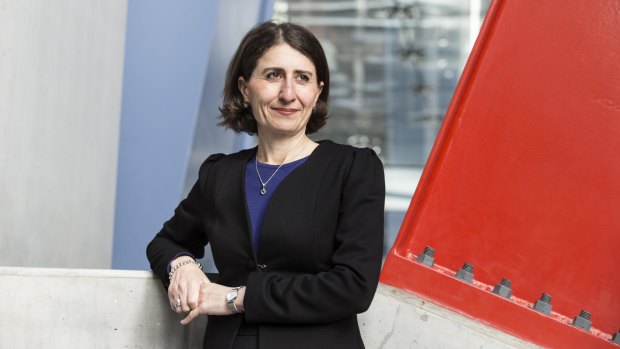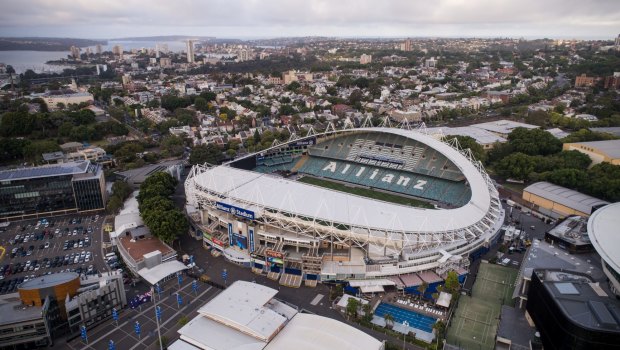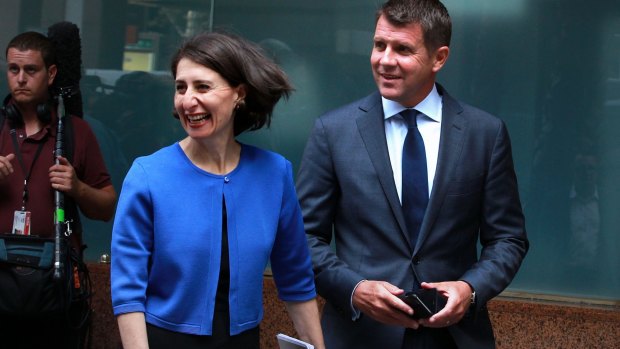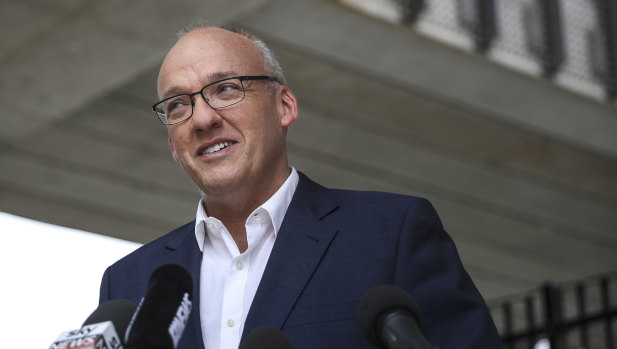By Alexandra Smith & James Robertson
As another sitting week was winding up in NSW Parliament this week, Gladys Berejiklian asked trusted senior Liberals to gauge the mood of her increasingly jittery backbench.
While the Premier and her sports minister Stuart Ayres stood firm all week on their decision to “deliver world class stadiums” to NSW - with a $2.5 billion price tag - MPs were getting nervous.
“She wanted us to test the waters with our colleagues,” a senior government source says. “When you talk to backbenchers, they are definitely concerned. But when you ask them what they don’t like about the policy, it’s not the stadiums they are worried about. It’s the shambolic way we have sold it. It’s our message.
“And that is going to be our problem over the next year. We don’t always get the politics right.”

Premier Gladys Berejiklian faces a number of hurdles in the lead-up to the next state election.Credit: Louie Douvis
NSW has been ranked the nation’s top economy for 14 straight quarters. The state will spend $80 billion on infrastructure in the next four years - more than the federal government will spend over the next decade. Crime rates are at a 25-year low. The budget surplus has reached $5.7 billion.
These are facts that senior Liberals believe should win over voters. Yet one year out from the government's bid to secure another four years in power, they are bracing for the prospect that Berejiklian may not be able to govern in her own right.
In a speech before the National Press Club in May 2017, coinciding with her first 100 days in office, Berejiklian praised reforming Liberal leaders such as Nick Greiner and Victoria’s Jeff Kennett but lamented their leaderships were relatively short lived.
She has made it clear she wants to lead a “long-term” reforming government. But only seven seats stand between her and the loss of her majority.
Stadiums backlash
When Berejiklian was handed the state’s most powerful job in January last year, she also inherited a folder full of political headaches. She set about neutralising them one by one.
But the government's latest quagmire, a revised stadiums policy announced last year, is one the Premier is closely tied to and not one she wants to overturn.
Berejiklian and Ayres have doubled down on their decision to spend about $2.5 billion on demolishing and rebuilding two Sydney stadiums - Allianz in the city’s east and ANZ in the city’s west. But some say they are out on a limb.
One MP said this week: “We are just giving a free pass to the opposition”. Another said: “We should be prepared to backflip, of course we should, because this election is going to be tough”.

The stadiums plan has resulted in a public backlash.Credit: Wolter Peeters
Deputy Premier John Barilaro has taken every opportunity in recent weeks to publicly indicate that the stadium plan is not a done deal. He told Parliament that the government still had to make a final decision and followed it up with a strong assurance that if there was “red hot anger out there”, the government would need to rethink the plan.
National Party sources say that Barilaro is telling colleagues that he wants the plan scaled back or even dumped.
Berejiklian has previously conceded that governments don’t always get it right. "I'm always happy to listen, always happy to consider what the community wants,” she told the Herald in December. "But there are also times when you make a decision, you stick by your guns because you know it's in the best interests of the community."
Berejiklian reversed several controversial decisions in her first six months in office. She wound back council mergers, postponed reform of an emergency services levy, and closed the door to the potential privatisation of several regional hospitals. But stadiums is not one she wants to overturn.
Meanwhile, the Labor Party has seized on the government’s commitment to spend the proceeds of the $2.6 billion sale of the land titles registry on the new stadiums. Several senior Labor Party sources have said they desperately want Berejiklian to stick to her plan because it hands them the perfect election pitch: “Schools and hospitals before stadiums”.
A senior Liberal said: “That’s the problem. We have got the policy right but Labor has the better politics.”
The return of One Nation
Berejiklian may be facing a potential hurdle to form government in the lower house but, even if she clears it, party campaigners are starting to worry about how she might deal with the make-up of the upper house after next year’s election.
The return of Pauline Hanson’s One Nation and the rise of Cory Bernardi’s Australian Conservatives could result in right-wing parties holding the balance of power in the Legislative Council.
Her colleagues say that Berejiklian forcefully condemned One Nation when she was leader of the Young Liberals in the mid-'90s. But she hasn’t gone so far as to rule out a preference deal with One Nation in NSW. It is a matter for the Liberals' organisational wing not the parliamentary party, she says.
The Shooters, Fishers and Farmers Party, which won the lower house seat of Orange in 2016 and has two upper house seats, are also sweating on the return of One Nation. MP Robert Brown is confident he will be re-elected to the upper house, but is expecting only one seat because One Nation will split its vote.
“We will be campaigning in 10 to 15 lower house electorates, primarily in National seats but also some Liberal seats, and I am confident we can hold Orange and win Murray this time around,” he said. “But there is no doubt that One Nation will hurt us.”
Upper Hunter, Dubbo and Barwon are also in the Shooters’ sights.
Meanwhile, Bernardi’s break-away right-wing party, the Australian Conservatives, ran fourth in a recent by-election in the federal seat of Bennelong, garnering just over 4 per cent of the vote.
High profile anti-halal campaigner Kirralie Smith has been touted as a possible star candidate for the Australian Conservatives in the upper house. Smith is considering her options.
Anger behind the scenes
Soon after he became Prime Minister, the NSW Liberals laughed in Malcolm Turnbull's face when he asserted the Liberals were not run by factions.
But Berejiklian has done much to quell anger and leaking within the party’s right wing about the influence of her own moderate faction in party preselections and its links to lobbyists.

Gladys Berejiklian with then premier Mike Baird in 2016.Credit: Ben Rushton
The Premier rewarded the diminished right wing of the Liberals with promotions in her new cabinet. Dominic Perrottet was made Treasurer and Anthony Roberts was given charge of planning, an area key to tackling housing affordability.
Also, in January the left and right worked together to broker a reform to the way the party preselected candidates.
The instinct to compromise reflects the Premier’s biggest difference with her predecessor, Mike Baird, according to those close to her.
“Cabinet ministers certainly appreciate her being in office more than Mike,” said one senior party source. “There’s not that sense of being dictated to by the Premier’s office”.
A key challenge
“Never say never,” John Barilaro said last week when asked about whether the government would back down on rebuilding the stadiums, noting that the government had not shied away from changing its mind on controversial policies before.
He helped engineer one of the biggest: the backdown on rural council mergers, a change of tack he openly demanded after securing the party leadership in late 2016.
One of the biggest challenges for the Coalition at next year’s election may be in regional NSW.
Four of the government’s six most marginal seats are currently held by the National Party, which will have its brand in regional NSW tested again, following the spectacular loss in the seat of Orange. The massive swing away from the Nationals cost Barilaro’s predecessor, Troy Grant, his job.
A concern for the Coalition in the regions is that slogans about NSW being No.1 will not resonate with electorates that feel they are not getting their share of the spoils.
The government had promised to spend one-third of its infrastructure budget in regional NSW but a review by the Auditor-General found last year it was spending less than half that much.
The government conceded this month that wasn’t good enough and said it was lifting its game when it announced it would spend the entirety of NSW’s $4-billion plus windfall from the sale of its share of the Snowy Hydro scheme to the federal government on new projects in regional electorates.
But Labor quietly believes many safer National seats may be in play next year because of discontent over perceived neglect. It may even be in with a shot of pulling off a massive, 13-point swing to claim the state’s largest electorate, Barwon, where the unpopularity of the incumbent retiring member Kevin Humphries and issues with water security could create a potent mix.
Labor’s push
The state election will be held on March 23 next year. Another headache for party strategists is a looming federal election, which could be a major problem for both parties if the Prime Minister goes to the polls before NSW.
Labor is already gearing up. Labor will head off on Sunday on a week-long road trip to the marginal seats in regional NSW. They will hold a shadow cabinet meeting in Queanbeyan - in Barliaro’s seat.

Opposition Leader Luke Foley is expected to lead Labor to the election.Credit: Cole Bennetts
Next week, the Labor bus will roll back into western Sydney for a campaign launch of sorts in Penrith, or "ground zero" as party strategists call it. The ALP is confident they can win Penrith - the seat held by Stuart Ayres, as well Mulgoa, Seven Hills, East Hills, Holsworthy and Heathcote.
Senior sources confirm the party is preparing for the contingencies of minority government and has held talks with the Greens about swapping a guarantee of supply in the lower house for possible rewards, such as granting them major party status and the extra resources that come with it.
Barring a spectacular scandal, Opposition Leader Luke Foley is expected to lead Labor to the election but there are replacements in the wings. The future leaders include Jodi McKay - a former minister who is seen as a good performer and a competent local member, and Michael Daley, a former roads minister and the deputy leader.
Treasury spokesman Ryan Park and Londonderry MP Prue Car are also contenders, although both are still considered too inexperienced, according to senior party figures.
One party strategist says Labor’s tactic will be to run micro-campaigns across the state, all focused on two crucial things: schools and hospitals.
“As long as they keep going with stadiums, everywhere we go we will just keep talking about about health and education,” the strategist says.
When asked what they plan to make the No.1 focus of their election campaigns, senior Liberal strategists also give the same answer: their investment in schools and hospitals.
It makes for a marked difference to state election campaigns that have previously been fought across ideological gulfs, such as 2015’s fight on electricity privatisation, or the law and order “auctions” that were famously a feature of state politics.
But the Liberals are expecting to point to their record health budget to neutralise Labor’s attacks and to heighten their own on the Opposition’s inexperience and history of mismanagement.
At the Liberal party’s annual general meeting in February, the party faithful roared as black-and-white video footage played of jailed former Labor ministers Eddie Obeid and Ian MacDonald.
But despite the potential damage Labor’s past poses on its re-election hopes, the Liberals know that their weakest link is selling their message to the voters of NSW.
“We are building schools, hospital, public transport. The economy is humming along. NSW has never been better,” a senior Liberal says.
“But we are going to have get better with the politics around our policies or we will keep having the same problems as we do with stadiums. Labor is all sell and no substance but, you have to say, they are effective.”